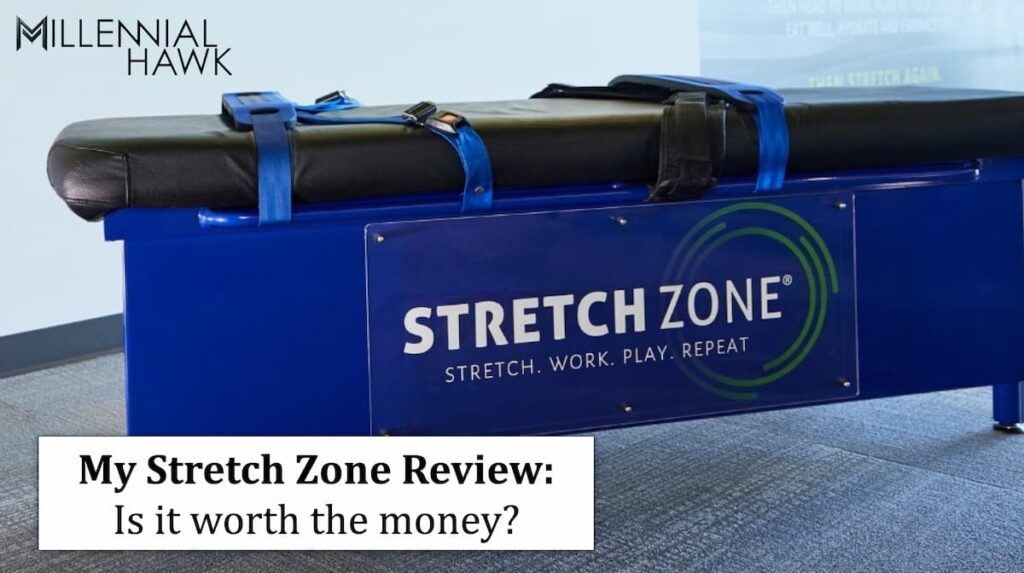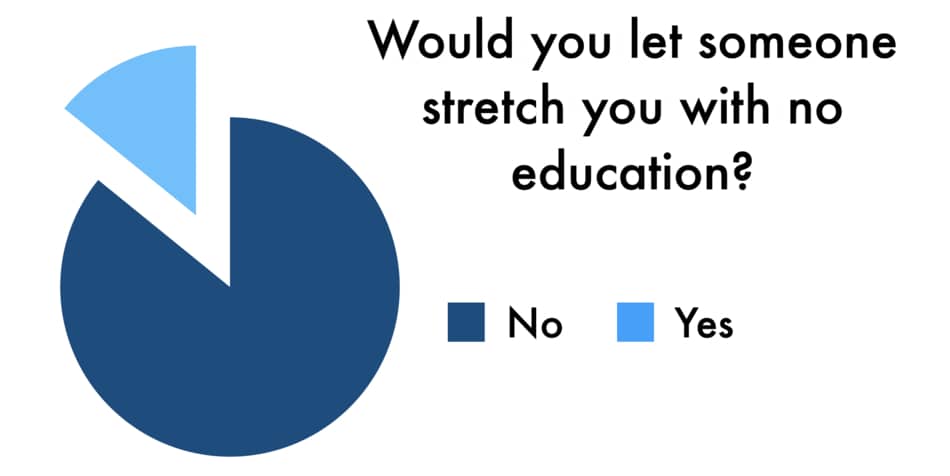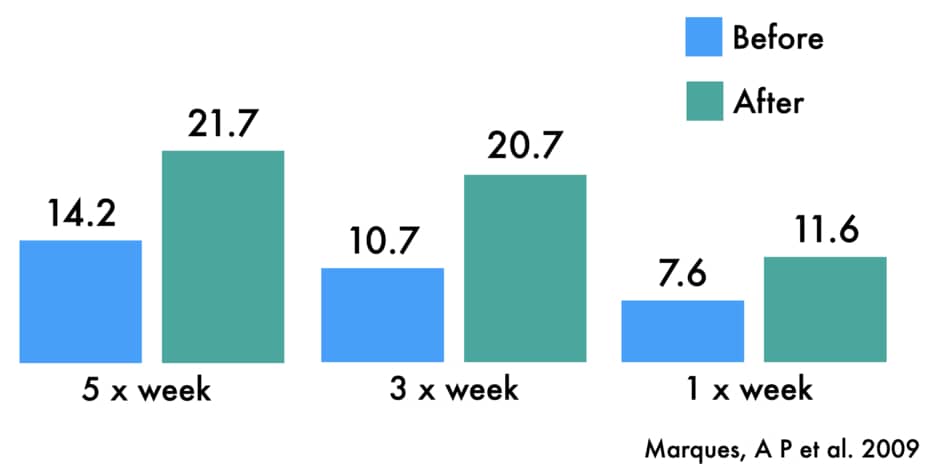Stretch Zone, a franchise company, specializes in assisted stretching and has over 200 locations in 22 states. Unlike traditional cardio or self-stretching at a fitness studio, Stretch Zone provides a unique experience with professional stretching sessions conducted by trained staff. They use a patented strapping system and proprietary tables to position, stabilize, and isolate muscles, aiming to modify the stretch reflex to gradually enhance the active range of motion without causing injury.
Although Stretch Zone prices are not transparently displayed, you can book your stretching session either via phone, the app or by walking into your nearest studio. The price for a 30-minute session is $55, and it’s $100 for a 60-minute treatment. While the regular Stretch Zone cost may seem steep, the company often offers discounts, such as 3 sessions for $99, as well as membership deals, which can vary depending on the location.
Stretch Zone is not the only option; if you’re searching for more cost-effective alternatives, there are many, including StretchLab, StretchMed, LYMBYR, KIKA, Stretch*d, Stretch U, iFlex Stretch Studios, and many more.

What Is Stretch Zone?
Stretch Zone refers to a wellness chain that specializes in practitioner-assisted stretching to improve flexibility and movement. The Stretch Zone’s purpose is to enhance your range of motion and flexibility by targeting the nervous system. This approach aims to reduce chronic joint and muscle pain, allowing you to move more freely without discomfort.
If you’ve been living off-grid for the past few years, you might not be aware that stretching franchises are the fastest-growing trend in fitness. Two of the most popular studios in this trend are StretchLab and Stretch Zone. Stretch Zone has gained popularity due to its unique approach to assisted stretching, professional atmosphere, and the growing awareness of the importance of flexibility in overall fitness and health.
Who founded Stretch Zone?
The Stretch Zone company was founded in 2004 by Jorden Gold, who improved his grandfather’s quality of life through stretching. The brand has seen rapid expansion, with 200 open locations as of May 2022 and an ambitious goal to open 300 more within the next year.
How does the Stretch Zone work?
Stretch Zone works by offering personalized one-on-one assisted stretching and mobility assessments. During each session, certified assisted stretching practitioners conduct a brief evaluation to gauge your range of motion and tailor your stretching therapy accordingly.
You can schedule your stretching session at Stretch Zone through your phone, their app, or simply by walking in at your nearest studio. A 30-minute session costs $55, while a 60-minute treatment is priced at $100, though prices may vary depending on the location.
It’s advisable to arrive at least 15-20 minutes early for your session, ideally after a brief warm-up (the studios provide ellipticals if you need to warm up). Despite my regular post-workout stretching routine, I decided to give Stretch Zone a try without hesitation.
The first time I tried Stretch Zone, I got hooked, not because of their customer service or a free session, but because they employ a patented strapping system that boosts your range of motion while ensuring your comfort. Other stretch studios, such as StretchLab or Stretch*d, don’t use these techniques.
What does the Stretch Zone do to your body?
Stretch Zone employs various stretching techniques and proprietary tables designed to position, stabilize, and isolate muscles. This approach ensures proper ergonomics for the stretch therapists through the use of stabilization straps. These methods collectively aim to improve flexibility, relieve tension, and enhance overall body mobility.
For example, Stretch Zone stabilization straps help to maintain the pelvis in one position while performing hamstring stretching or manipulation. This way you get a greater range of motion, without getting any lumbar flexion from the client.
I like this system because you can provide better stretch therapy with minimal strain on the therapist. Of course, using stabilization straps or massage bed straps is nothing new. Many physiotherapists, massage therapists, and chiropractors use straps to isolate the hips, pelvic region, and back in their treatment rooms.
What are the benefits of the Stretch Zone?
The following are the benefits of attending the Stretch Zone every week.
- Improved Flexibility: A study by Nakamura et al. (2014) found that active muscle stretching significantly increased flexibility in participants, suggesting that regular stretching can enhance the range of motion in joints.
- Decreased Muscle Tension: According to Suzuki et al. (1999), individual muscle stretching aims to reduce muscle tension, which can lead to improved joint dexterity and reduced discomfort associated with tight muscles.
- Enhanced Circulation: According to a 2012 study conducted by Phil Page, PT, PhD, stretching is believed to enhance circulation. This belief is supported by studies indicating that stretching can have a positive impact on blood flow.
- Injury Prevention: Regular stretching is often recommended for injury prevention, as it can help maintain muscle health and joint range of motion, potentially reducing the risk of strains and sprains.
- Improved Athletic Performance: Dynamic stretching, which involves controlled movements, has been shown to positively affect subsequent performance in force, power, sprint, and jump activities, likely due to reduced muscle-tendon unit stiffness and temperature-related mechanisms.
What are the drawbacks of the Stretch Zone?
The drawbacks of Stretch Zone include the high cost of sessions, the need for multiple sessions to see significant results, and the substantial time commitment required for regular appointments. The following list outlines the disadvantages of the Stretch Zone.
- High cost of sessions.
- Multiple sessions are needed for significant results.
- Substantial time commitment for regular appointments.
- Practitioners may lack formal education in physiotherapy or physical training.
- In-house certification may not cover health-related causes of pain or stiffness.
- May not be suitable for individuals with complex mobility issues.
One thing that I don’t like about the Stretch Zone is their recruitment and in-house training. In a nutshell, people who work there are not physiotherapists or physical trainers. These are fitness enthusiasts who finished an in-house certification course.
Sure, you can stretch someone’s hamstrings or lower back without formal education in anatomy and physiology. However, the Stretch Zone practitioners are not qualified to recognize and treat any health-related causes of pain or stiffness. Most of the members I’ve seen are untrained, overweight, or elderly, which means they have many mobility problems.
What is the stretch zone monthly cost?
The Stretch Zone monthly cost varies depending on your session frequency and duration. If you attend three sessions per week, it will typically range from $600 to $900 per month. For those doing one session per week, the monthly cost is around $200 to $400. You can potentially lower your Stretch Zone monthly cost by exploring membership options and packages. Please note that prices may vary by location, but on average, 30 minutes session is approximately $35.
What are the Stretch Zone pricing packages?
Stretch Zone offers pricing packages in three options: 4 sessions, 8 sessions, and 12 sessions.
Is Stretch Zone worth the money?
Yes, Stretch Zone is a worthwhile investment, particularly for individuals with busy lifestyles, limited flexibility, or difficulty stretching on their own. It can serve as a valuable alternative to massages or chiropractic care and is effective for preventive purposes. However, if you’re already active and possess a full range of motion, such as a dancer, martial artist, or gymnast, you may not experience significant benefits from Stretch Zone compared to your own post-workout stretching routine.
Who is Stretch Zone good for?
Stretch Zone is beneficial for individuals who spend most of their day behind a desk and lack the time or expertise for daily stretching. It is also advantageous for those looking to enhance their mobility and regain their range of motion. Additionally, it’s a valuable option for anyone dealing with UCS (upper cross syndrome), lower back pain, or neck pain resulting from inactivity or prolonged sitting positions.
It’s not a secret that sitting at a desk for eight hours a day can lead to stiffness and tension (which is why I’ve signed up for the membership). I also highly recommend this place for everyone who wants to reduce muscle aches and pains after a workout, improve flexibility, as well as reduce stress and anxiety.
Here is the list of people who would benefit from doing Stretch Zone:
- Management positions
- Lawyers
- Accountants
- Financial and insurance workers
- Consultants
- Computer programmers.
- Receptionists and clerks.
- Drivers (bus, truck, taxi, Uber)
On the other hand, Stretch Zone may not be ideal for individuals who are already highly flexible, younger individuals, professional athletes, or those with chronic conditions that require specialized physiotherapy.
Is Stretch Zone safe?
Yes, the Stretch Zone is generally safe for individuals seeking to enhance their range of motion, including those with sedentary lifestyles. However, it is not advisable for individuals with musculoskeletal injuries, as it may not be suitable for their specific needs.
I did a small survey on social media forums and groups asking people just one question about how important is the practitioner’s qualifications.
The question of the survey was “If you were having a previous or current musculoskeletal injury, would you go to the Stretch Gym that employs fitness enthusiasts without a diploma in physiotherapy?“.
Here are the results.

Over 83% of people said that they would not want someone without format education to stretch them if they had a previous or current musculoskeletal injury. Only 16% of people responded they would go, depending on the price, type of injury, and experience of the therapist.
Of course, I’m not picking up on the Stretch Zone (please remember that I’ve signed up for their membership). I only say that people who present with more serious problems should visit their PT, not the Stretch Zone.
How often should I go to Stretch Zone?
You should go to Stretch Zone at least three times per week, depending on the duration of the session, your budget, and your main concern. People who choose a 60-minute session should visit the studio twice per week, whereas people who stretch for 30 minutes should come in three times.
This recommendation is grounded in a 2009 study conducted by Dr. Amélia Pasqual Marques from the Universidade de São Paulo in Brazil. The study documented the distinctions between stretching once a week, three times a week, and five times a week.
The results have shown that:
- There was no significant difference between stretching five times a week and three times a week (meaning they were equally effective).
- Stretching once a week provides some, but not significant results.
- Stretching three times a week is sufficient to improve flexibility compared to stretching at a higher frequency.
The following diagram illustrates the effect on flexibility from stretching once, three times, or five times per week.

How does a Stretch Zone session begin?
A Stretch Zone session typically begins with a brief assessment to understand your fitness goals, lifestyle, and current mobility and flexibility status. During the session, practitioners use techniques such as PNF, static, and dynamic stretching, along with manipulations and joint distractions to improve your flexibility and mobility.
Should you warm up before coming to Stretch Zone?
Yes, you should warm up before visiting Stretch Zone. Warming up helps increase blood flow and raises your core body temperature, making your muscles more elastic and flexible. Stretching without a warm-up can increase the risk of muscle strain, pulling, or tearing.
Is it OK to do Stretch Zone every day?
Yes, stretching every day at Stretch Zone is generally okay, as long as you don’t overdo it. However, keep in mind that doing Stretch Zone daily can cost you approximately $250 to $500 per week.
What should I wear to the Stretch Zone?
For your Stretch Zone session, opt for comfortable sports attire like shorts, leggings, or t-shirts. Casual wear like track pants and yoga pants is also suitable. Avoid wearing jeans, as they can limit your range of motion.
Should I leave a tip at Stretch Zone?
In general, it’s a good practice to leave a tip of around 10-20% at Stretch Zone when you’ve had an excellent experience with their service. However, if you’ve received subpar service, it’s advisable to speak with the studio’s general manager instead.
Which stretch studios are similar to Stretch Zone?
Stretch Zone alternatives include StretchLab, which boasts a large number of locations, and StretchMED, which has around 50 locations. Other similar stretch studios are LYMBYR, a boutique franchise from NYC, KIKA with 6 locations, Stretch*d from NYC, Stretch U, and iFlex Stretch Studios, all offering assisted stretching services.
What’s the difference between Stretch Zone and StretchLAB?
The key difference between Stretch Zone and StretchLAB lies in their equipment. Both companies employ various advanced stretching and mobilization techniques, including PNF (proprioceptive neuromuscular facilitation) techniques. However, StretchLAB utilizes massage guns in their sessions, while Stretch Zone uses straps as part of their stretching approach.
What’s the difference between Stretch Zone and StretchMED?
The main distinctions between Stretch Zone and StretchMED lie in their popularity and the techniques they employ. Stretch Zone boasts a network of over 200 locations, while StretchMED operates with approximately 50. Additionally, Stretch Zone utilizes a proprietary method that employs straps to stabilize specific body parts, while StretchMED relies solely on manual techniques without the use of any additional tools.

Friendly, ok: safe, not so sure. Without medical qualifications, I’d be hesitant.
I tried Stretch Zone for 3 months. Before I started I had been stretching myself every day for 15 minutes and an hour on Sunday. My physical condition is athletic. What I learned from Stretch Zone is that was not getting the full benefit of my personal stretch sessions. My personal stretch sessions are probably 50% more effective now. Also during my Stretch Zone sessions, there were benefits I couldn’t do myself. I will continue with Stretch Zone sessions at a maintenance level.
Today, October 19, 2023, I went for my first free Stretch Zone session. It is located on Havendale Blvd and 21 street in Winter Haven Florida. My session was GOOD, and my instructor was excellent. BUT! I am very very disapponted that there was not a pamphlet with the prices given out. Yes, I was shown on the IPAD the different session with amounts but that is not enough for me.
Then to find out the are no business cards either—–nothing on line with prices either?? Why??
So even if I wanted to join a plan I have NOTHING to refer back to.
Hey Elaine, I guess it’s because the stretch zone prices are high
Hey, my wife is a school teacher on her feet all day, and she comes home, and her feet are killing her. Does stretching help with her feet? Sometimes, her feet hurt so bad she can’t hardly walk. Could this help her feet and lower body area?
As for myself, I have shoulder issues on the left side from lack of use. I am 74 and have been in sports most of my life. I have seen several chiropractors, but they don’t seem to work, and it makes me angry when the next day I still hurt.
Do you guys accept Medicare?
I have no professional medical training, but my partner suffered from severe back and ankle pain due to a broken ankle. He found relief by putting his legs up against a wall, so an L-shape with your torso on the ground. I also suggested this to my father, who broke his heel in multiple places nearly two decades ago and still experiences pain. After trying this for 30 minutes while sitting on the couch, he experienced instant relief, and had no foot pain for the rest of the day. Could be worth a shot!